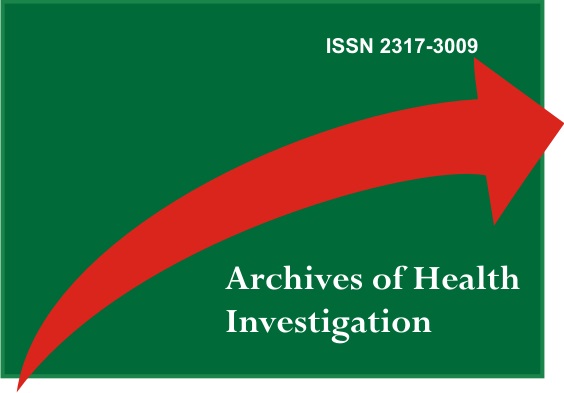Use of silicones in fixed aesthetic rehabilitations: clinical case
DOI:
https://doi.org/10.21270/archi.v10i5.5066Palavras-chave:
Denture, Partial, Fixed, Dental Impression Materials, ElastomersResumo
Molding in a fixed prosthesis is one of the most important stages in rehabilitative treatment, as it is there that attempts are made to reproduce dental preparations and adjoining regions by using appropriate materials and techniques. Among the fixed prosthesis molding materials available on the market, the elastomers stand out, which are polymers where the prey occurs through the increase of the chain and the establishment of cross-links. The objective of the study is to present a clinical case and perform a literature review on the use of condensation silicone and addition to molds in Fixed Prosthesis. In this literature review, a survey of PubMed, Scielo and Lilacs data was performed, using the descriptors: Denture, Partial, Fixed; Dental Impression Materials and Elastomers. It is possible to conclude that in the field of Dentistry, the elastomers, among them the condensation-cured and addition-cured silicones, both provide high precision models and are the most used materials in works with fixed partial dentures. Therefore, it is up to the professional to know the properties and adapt to the best group of chosen materials.
Downloads
Referências
Anusauice K, Phillips - Dental Materials, 11 ed. Rio de Janeiro: Elsevier. 2010
Aldrovandi, C. Molding materials. In: TAMAKI, T. Complete dentures. Folha Odontologica. São Paulo: cap. 4, p. 103-119. 1953
Almeida, EES. Study of dimensional change in molding silicones polymerized by condensation reaction.Rev. Fac. Odontol. Bauru, Bauru, v. 10, n. 4, p. 275-281. 2002
Antunes, RPA. Evaluation of the ability to copy elastomeric impression materials from different systems using a clinically applicable technique Oct. / Dec. 1997. Rev. Odontol. Univ. São Paulo, Bauru v. 11, n. 4, p. 263-271.
Alves MC, SOARES CR, ZANI IM. Dimensional stability of polyester and polysulfide molds obtained with the acrylic cap technique, cast in special stone plaster type iv and Apr./Jun.Rev. Odonto. Ciênc, Porto Alegre, vol. 20, n. 48, p. 120-125. 2005.
Bustamante, CG. Evaluation of dimensional change in vitro between two different commercial brands of addition and condensation polymerization silicones. In: CONGRESS OF SCIENTIFIC INITIATION OF THE UNIVERSITY OF MOGI DAS CRUZES, Mogi das Cruzes. Anais… Bauru: [S.l.], p.77, 2009.
Craig RG, Powers JM, Wataha JC. Dental Materials: Properties and Handling, 2002. 7ed. São Paulo: Santos.
Dias, SC. Analysis of the ability to reproduce details expressed by different modeling materials.Rev Odontologia, Belo Horizonte, v. 43, no 4, p 137-143, 2007.
Eduardo, CP. Contribution to the Study of Dimensional Alteration of Molding with Relief and without Relief, with Material Based on Silicone.51f. Thesis (Doctorate in Dental Materials) - Faculty of Dentistry, University of São Paulo, São Paulo, 1986.
Idris, B. Comparison of the dimensional accuracy o fone- and two-step technique with the use of putty wash addition silicone impression materials. Jounal Prosthetic Dentistry. 74 (5): 535-41, 1995.
Fonseca, DR. Moulding materials. In: NOORT, R. V. Introduction to dental materials. Rio de Janeiro: Elsevier. chap. 2.7, p. 175-195, 2010.
Higashi C, Gomes JC, Kina S, Andrade OS, Hirata R. Aesthetic planning in anterior teeth. Aesthetic Dentistry: 7: 139-154, 2006.
Johson GH, Craig RG. Accuracy of four types of rubber impression materials compared with time of pour and reapeat pour of models. Prosthetic Dentistry Journal. Feb 55 (2): 197- 203. 1998
Klee Vasconcellos, D. Precision Moldings in Dentistry: Literature Review. Clinical Laboratory Prosthesis 7 (35): 90-100. O'BRIEN, W. J. Molding materials. In: Dental materials. Rio de Janeiro: Inter-American, 1981. ch. 10. p. 106-123, 2005.
Lelis V. Bisacrylic resins: characteristics of temporary restorations. State University of Campinas: Campinas, 2014.
Marcinakit, CF. Linear Dimensional Changesi Elastic Impression Materials, July J. Dent. Res., V.59, no.7, p.1152-1155, 1998.
Martins, JT. Analysis of precision and reproducibility of an intraoral scanner- clinical study. 2014. 92f. Dissertation (Integrated Master in Dental Medicine) Instituto Superior de Ciências Egas Moniz, Almada. Pegoraro LF. Fixed prothesis. Sao Paulo. Medical Arts. 1st edition. EAP-APCD, 2014.
Mesquita, VT. Molding materials and techniques in fixed prosthesis .Literature review. São Lucas Educacional; 427- 38, 2012.
Mezzomo E, Suzuki R, Makoto. Contemporary Oral Rehabilitation. 1st ed. Sao Paulo. Santos, 2006.
Nissan, J. Accuray of three polyvinyl siloxane putty wash impression techniques. Journal Prothetic Dentistry.Feb. 83 (2): 161-165, 2000.
O'brien, WJ. Molding materials. In: Dental materials. Rio de Janeiro: Inter-American, ch. 10. P. 106-103, 1981.
Pegoraro, LF. Fixed Prosthesis: bases for planning in oral rehabilitation. 2nd ed. Sao Paulo. Medical Arts, 2013.
Pierri G, Libanori CMB and Matson E. Study of the dimensional stability of molding with silicones as a function of storage, storage time and relief in the condensation silicone. R. Paul. Odontol. São Paulo, Dueneden, V13, n 4, p8-16, 1991.
Phillips, RW. Elastic Molding Materials: Alginates (Irreversible Hydrocolloids). In: Skinner Dental Materials. Rio de Janeiro, Guanabara Koogan, 9th ed, p. 74, 1993.
Reed A, Bompolaki D, Garaicoa J. Dental Impression Materials and Techniques. Oct. Dent. Clin. Noth. Am., Philadelphia, v 61, No. 4, p. 779-96, 2017.
Shada OP, Adegbulugbe IC, Oderinu OH. Dimensional stability of alginate impression material over a four hours ’time frame. Niger. Q.J HOSP. MED. Lagos, v 17, n 1, p. 1-4, 2007.
Sinhoreti, MAC. Study of the dimensional accuracy of plaster models made with different techniques and elastomeric molding materials. Magazine of the Faculty of Dentistry of the University of Passo Fundo,15 (2): 139-14,2010.
Send D, Goller G, Issever H. The effect of two polishing pastes on surface roughness of bis-acryl methacrilate based resins. J Prothet Dent; 88: 527-32, 2002.
Soares, LA. Elastomers: their use in fixed prostheses. [S.l : s.n.],1975.
Veiga, LA. Analysis of the evolution of materials and molding technology in terms of printing capacity and stability: literature review. 52f. Graduation course conclusion work (Federal University of Rio Grande do Sul), 2018.


